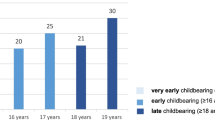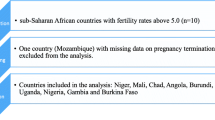Abstract
Background
Marriage below the age of 20 brings negative health consequences to female adolescents. Ethiopia is one of the top ten countries with the highest rates of child marriage despite the minimum legal age at first marriage was 18 years.
Objective
To assess the prevalence of adolescent marriage and its associated factors among young women of Delanta District, North-East Ethiopia.
Methods
A community-based cross-sectional study was conducted on 597 adolescent women between the age of 15 and 19. A cluster sampling technique was used for this study. Data were entered and cleaned by EpiData-3.02 and analyzed by SPSS-20.
Results
Around 40% of adolescents were married at the time of the survey. Adolescent marriage was twice higher among girls below the age of 18 (AOR: 2.12, 95%CI (1.15, 3.90)). Lack of comprehensive knowledge on obstetrics fistula prevention increases the risk of adolescent marriage by three folds.
Conclusion
This study indicated that adolescent marriage was higher in the area. Delaying the age at first marriage by implementing the Ethiopian Family Code proclamation is needed
Similar content being viewed by others
Availability of Data and Materials
The data sets used and analyzed for the study are available from the corresponding author on reasonable request. The investigators are responsible for all information provided to the journal.
Abbreviations
- CSA:
-
Central Statistical Agency
- EDHS:
-
Ethiopian Demography and Health Survey
- IHRERC:
-
Institutional Health Research Ethics Review Committee
- STIs:
-
Sexually transmitted infections
- OFP:
-
Obstetric fistula prevention
References
Adedokun, O., Adeyemi, O. & Dauda, C. (2016) Child marriage and maternal health risks among young mothers in Gombi, Adamawa State, Nigeria: Implications for mortality, entitlements and freedoms. African health sciences, 16, 986-999.
Adler, A. J., Ronsmans, C., Calvert, C., & Filippi, V. (2013). Estimating the prevalence of obstetric fistula: A systematic review and meta-analysis. BMC Pregnancy and Childbirth, 13, 246.
Ahmed, S., & Tunçalp, Ö. (2015). Burden of obstetric fistula: From measurement to action. The Lancet Global Health, 3, e243–e244.
Ali, A., Ibrahim, I., Abdelgbar, S., & Elgessim, M. (2014). Socio-demographic factors affecting child marriage in Sudan. J Women’s Health Care, 3, 163.
Asp, G., Pettersson, K. O., Sandberg, J., Kabakyenga, J., & Agardh, A. (2014). Associations between mass media exposure and birth preparedness among women in southwestern Uganda: A community-based survey. Global health action, 7, 22904.
Banke-Thomas, A. O., Kouraogo, S. F., Siribie, A., Taddese, H. B. & Mueller, J. E. (2013). Knowledge of obstetric fistula prevention amongst young women in urban and rural Burkina Faso: A cross-sectional study. PloS One, 8.
Carlson, E. (1979). Family Background, School and Early Marriage. Journal of Marriage and Family, 41.
Central Statistical Agency. (2007). Central Statistical Agency of Ethiopia: population and housing census report.
Central Statistical Agency. (2017). Ethiopia Demographic and Health Survey 2016 The DHS Program ICF, Rockville, Maryland, USA.
Central Statistical Agency [Ethiopia] and Orc Macro. (2006). Ethiopia Demographic and Health Survey 2005 Addis Ababa Central Statistical Agency and ORC Macro Ethiopia and Calverton, Maryland, USA
Darroch, J. E., Woog, V., Bankole, A., Ashford, L. S. & Points, K. (2016). Costs and benefits of meeting the contraceptive needs of adolescents. Guttmacher Institute.
DSW. (2011). German Foundation for World Population: Fight Fistula : Educating and Empowering Women in Ethiopia
Erulka, A. (2013). Early marriage, marital relations and intimate partner violence in Ethiopia. International Perspectives on Sexual and Reproductive Health, 39.
Ethiopia, S. P. (2007). Federal Negarit Gazeta of the Federal Democratic Republic of Ethiopia. Proclamation No. 513/2007. Addis Ababa, 12 February 2007.
Gage, A.J. (2009). Coverage and effects of child marriage prevention activities in Amhara Region, Ethiopia.
Godha, D., Hotchkiss, D., & Gage, A. (2011). The influence of child marriage on fertility, fertility-control, and maternal health care utilization: A multi-country study from South Asia. Chapel Hill, NC: MEASURE Evaluation PRH.
Gurmu, E., & Mace, R. (2013). Determinants of age at first marriage in Addis Ababa, Ethiopia. Journal of Social Development in Africa, 28, 87–110.
Haue M, Hossain S, Ahmed KR, Sultana T, Chowdhury, H. & Akter J. (2015). A comparative study on knowledge about reproductive health among urban and rural women of Bangladesh. Journal of family and reproductive health, 9.
Hodgkinson, K., Koster, W., & Miedema, E. (2016). Understanding and addressing child marriage. Amsterdam: University of Amsterdam.
Hotchkiss, D. R., Godha, D., Gage, A. J., & Cappa, C. (2016). Risk factors associated with the practice of child marriage among Roma girls in Serbia. BMC international health and human rights, 16, 6–6.
Ikamari, L. D. (2005). The effect of education on the timing of marriage in Kenya. Demographic Research, 12, 1–28.
Inbaraj, S. (2015). Married as children, women with obstetric fistulas have no future: Population Reference Bureau
Jones, N., Tefera, B., Stephenson, J., Gupta, T., Pereznieto, P., ... Emire, G. (2014). Early marriage and education: the complex role of social norms in shaping Ethiopian adolescent girls’ lives (pp. 1–103). Country Report: Shaping policy for development.
Kalembo, F. & Zgambo, M. (2012). Obstetric fistula: A hidden publichealth problem in sub-Saharan Africa. Arts and Social Sciences Journal, Vol.ASSJ-41
Marchetta, F., & Sahn, D. E. (2016). The role of education and family background in marriage, childbearing, and labor market participation in Senegal. Economic Development and Cultural Change, 64, 369–403.
Marrone, G., Abdul-Rahman, L., de Coninck, Z., & Johansson, A. (2014). Predictors of contraceptive use among female adolescents in Ghana. African journal of reproductive health, 18, 102–109.
Montazeri, S., Gharacheh, M., Mohammadi, N., & Alaghband Rad, J. & Efterkhar Ardabili, H. (2016). Determinants of early marriage from married girls’ perspectives in Iranian setting: A qualitative study. Journal of environmental and public health, 8615929–8615929.
Nasrullah, M., Zakar, R., Zakar, M. Z., Abbas, S., Safdar, R., Shaukat, M., & Krämer, A. (2014). Knowledge and attitude towards child marriage practice among women married as children-a qualitative study in urban slums of Lahore Pakistan. . BMC Public Health, 14, 1148.
Nayak, B.K. (2013). Child marriage in Ethiopia -A matter of concern. International Journal of Management and Social Sciences Research, 2.
Nour, N.M. (2006). Health Consequences of Child Marriage in Africa. Emerging Infectious Diseases, 12.
Okeowo, T., & Olujide, M. (2014). Attitude, knowledge and utilization of family planning methods among rural women in Ogun State, Nigeria. Agrosearch, 14, 39–53.
Olson, C. (2014). 16 ways of preventing and intervening in child marriages.
Páez, D. A. S. & Ortega, J. A. (2016) Adolescent contraceptive use and its impacts on early marriage and fertility.
Raj, A., Saggurti, N., Lawrence, D., Balaiah, D., & Silverman, J. G. (2010). Association between adolescent marriage and marital violence among young adult women in India. International Journal of Gynaecology and Obstetrics: the official organ of the International Federation of Gynaecology and Obstetrics, 110, 35–39.
Raja, A., Saggurtic, N., Lawrencea, D., Balaiahd, D. & Silvermane, J.G. (2010). Association between adolescent marriage and marital violence among young adult women in India. International Journal of Gynaecology and Obstetrics , 110.
Sabbe, A., Oulami, H., Zekraoui, W., Hikmat, H., Temmerman, M., & Leye, E. (2013). Determinants of child and forced marriage in Morocco: stakeholder perspectives on health, policies and human rights. BMC international health and human rights, 13, 43–43.
Sah, R., Gaurav, K., Baral, D., Subedi, L., Jha, N., & Pokharel, P. (2014). Factors affecting early age marriage in Dhankuta Municipality, Nepal. Nepal Journal of Medical Sciences, 3, 26–30.
September 8, 2016. “Our Time to Sing and Play” child marriage in Nepal: https://www.refworld.org/docid/57d2affd4.html
Speizer, I. S., & Pearson, E. (2011). Association between early marriage and intimate partner violence in India: A focus on youth from Bihar and Rajasthan. Journal of interpersonal violence, 26, 1963–1981.
Svanemyr, J., Chandra-Mouli, V., Christiansen, C. S., & Mbizvo, M. (2012). Preventing child marriages: First international day of the girl child “my life, my right, end child marriage.” Reproductive health, 9, 31–31.
Svanemyr, J., Chandra-Mouli, V., Raj, A., Travers, E., & Sundaram, L. (2015). Research priorities on ending child marriage and supporting married girls. Reproductive health, 12, 80–80.
Tebeu, P. M., Fomulu, J. N., Khaddaj, S., Bernis, L., Delvaux, T., & Rochat, C. H. (2012). Risk factors for obstetric fistula: A clinical review. International Urogynecology Journal, 23, P387-394.
UNITED NATION POPULATION FUND. (2012). Marriying to Young. End Child Marriage: Global & Regional levels and Trends.
UNITED NATIONS CHILDREN’S FUND. (2014). Ending Child Marriage: Progress and prospects. New York: UNICEF.
Yount, K. M., Crandall, A., Cheong, Y. F., Osypuk, T. L., Bates, L. M., Naved, R. T., & Schuler, S. R. (2016). Child marriage and intimate partner violence in rural Bangladesh: A longitudinal multilevel analysis. Demography, 53, 1821–1852.
Zwang, J., & Garenne, M. (2008). Social context of premarital fertility in rural South-Africa. African journal of reproductive health, 12, 98–110.
Acknowledgements
I would like to express my sincere and heartfelt gratitude to Delanta District Administrative Office for the provision of the necessary information that was an important input for the study; the Galladi Health Office for their support in every aspects of the research work. Also, I would like to thank study participants who were devoted their time to participate in the study; the community of selected sites of the district for their cooperation in all aspects they were asked. Finally, my everlasting love and appreciation is to my family especially my brothers Dessalew Adane and Wunete Masresha for their special support and all other family members and friends for their help.
Funding
Haramaya University covered all the costs incurred by the study.
Author information
Authors and Affiliations
Contributions
SAM, MWK, and GDA wrote the proposal and participate in the data collection and entry processes. They analyzed the data, drafted, read, and approved the manuscript.
Corresponding author
Ethics declarations
Ethical Approval
All procedures performed in studies involving human participants were under the ethical standards of the institutional and/or national research committee and with the 1964 Helsinki declaration and its later amendments or comparable ethical standards.
Informed Consent
Permission and ethical approval were obtained from Haramaya University College of Health and Medical Science after an ethical review of the contents of the proposal by the University Institutional Health Research Ethics Review Committee (IHRERC). Written, informed, and signed consent were taken from respondents of age 18 and above, and for those aged below 18 years, informed, written, and signed consent were taken from their guardian’s (biological families, caregiver, and husband) before their voluntarism and assent from the participants for interview. We confirmed that the IHRERC approved minor consents for this study. Participation in the study was fully voluntary.
Consent for Publication
This manuscript does not contain any individual/personal data in any form, so it does not need consent for publication.
Conflict of Interest
The authors declare that they have no any conflict of interest.
Rights and permissions
About this article
Cite this article
Masresha, S.A., Kassaw, M.W. & Alen, G.D. Adolescent Marriage in Northeast Ethiopia: The Case of Delanta District . Glob Soc Welf 8, 171–179 (2021). https://doi.org/10.1007/s40609-021-00206-7
Accepted:
Published:
Issue Date:
DOI: https://doi.org/10.1007/s40609-021-00206-7





